Oktaven Audio & The New Music Movement
“In the last ten years, the new-music scene in New York has completely exploded,” says Ryan Streber, composer, recording engineer and co-owner of Oktaven Audio.
“It’s unbelievable how many ensembles there are now, and how many new venues and labels there are for performances by those ensembles, playing music by not only living composers but by young composers.”
For the uninitiated, “new music” is a genre defining the intersection of contemporary classical, acoustic and experimental music. It’s a high art performed by virtuosic musicians whose influences span the ages, embracing the work of the European masters, the neo-classical and the post-modern minimalist composers, and a wide spectrum of everything else from American folk and blues, to German electronica to modern indie rock and popular music.
As a Millennial Juilliard-trained composer, Streber has been immersed in this scene as it’s grown, going back personally with influential composers like Nico Muhly and Jefferson Friedman and groups like the International Contemporary Ensemble (ICE), ACME, and counter)induction. He caught the recording bug as a composer striving to capture the best performances of his own compositions, and along the way, saw a growing need for a recording facility tailored to this music community.
Two years ago, Streber and his partner – visual artist/designer Jessica Slaven – opened Oktaven Audio, a recording studio located on Main Street in downtown Yonkers.
OPPORTUNITY: OKTAVEN
As a location recordist, prior to opening Oktaven, Streber would often be hired by Juilliard and Manhattan School of Music students producing their own CDs, or in need of audio for professional auditions.
“It killed me because we were getting into whatever space we could find which usually was pretty compromised,” he says, looking back. “And almost harder than finding a good sounding space was finding a good sounding piano.”
Oktaven came about when Streber and his partner, visual artist/designer Jessica Slaven, began looking around for space to build a modest “demo studio,” and found a large commercial space up in Yonkers, a former dance studio that had been vacant nearly a decade. Located conveniently around the corner from the train station in a much larger space than they’d expected to find, they saw potential for more than a demo studio. And then, again to their surprise, they found an amazing piano.
“It was one of those wonderful strokes of good luck,” Streber says. “We walked into Klavierhaus thinking nothing would be within our reach, and we struck up a conversation with a man named Arlan Harris, who wound up becoming a close partner with us. He was interested in what we were doing and we loved the work he did on these pianos. We ended up with this beautiful 9’ Hamburg Steinway D concert grand piano that was completely rebuilt by Arlan and Klavierhaus. It’s just a fabulous instrument, a wonderful sounding piano. That, in itself, is a big attraction.
“And then, having space – a live room that’s able to accommodate up to 14-person ensembles with percussion setups and piano all playing in the same room – that’s also something that’s become rare in the city.”
Streber, too, though he may not consider himself one, is also a rarity. The contemporary classical, jazz and acoustic ensembles that Streber had in mind when building Oktaven needed more than just the space and the piano. They needed a kindred spirit to construct and run it – someone who would create an environment to suit their sonic and personal aesthetics and to then engineer recordings accordingly.
Streber and Slaven built Oktaven, named after Brahms’ published notebook Oktaven und Quinten (Octaves and Fifths) – a symbol of the composer’s obsession with advancing his craft – to address this contemporary group: players with particular sensitivities, refined ears, and often very specific plans in the studio.
A NEW STUDIO EXPERIENCE
In concept and practice, the professional recording studio is not necessarily the ideal venue in which to record a classical or new-music performance. Many of the musicians are unfamiliar with the studio recording process, or have been turned off to it.
“In a perfect world, you’d always be recording in the Academy of Arts & Letters or something,” says Streber. “Most artists have cultivated their sounds to work in a big hall. But with a lot of the projects we do, either the budget doesn’t allow for that, or they actually need more control and precision – ability to do recalls, etc. – for whatever reason.”
The lack of budget-appropriate halls and negative experiences in the plan b recording studios has been a huge issue, according to Streber.
“Some classical musicians come in and have done session work, or they like the process, but I would say they are the minority. Most classical musicians I deal with are skeptical of any studios – they’ve either had bad experiences in studios, or they don’t like playing without an audience. Classical music is in a lot of ways designed to be live music and the studio environment can psyche a lot of people out.”
As a Juilliard-trained composer (BMA 2001; MMA 2003) and performer, Streber himself can be a positive first impression for skeptical clients. “I can sit and read scores and be a part of the process on that level, which – there are definitely some wonderful engineers in the city who do classical music, but it’s not the majority by a long shot.”
Oktaven will also look and feel unlike many traditional recording studios. Filled-to-the-brim bookshelves line two walls of one end of the 1,000-square-foot live room. Sitting at the grand piano, you could be playing in someone’s living room.
“The environment is very comfortable, and the tracking room itself is ‘live’ enough that the musicians will get some feedback. So they don’t feel like they’re playing in a completely dead studio, which is what a lot of them have experienced playing in other studios (this is especially hard for string players and singers).
“I designed the room to be live in a way that’s useful for the performer, but controlled enough that I can shape it. I almost always use some kind of artificial reverb to flesh out the sound.
And the books – we learned – are not the classical equivalent of the X-Box console for downtime entertainment. They make up Oktaven’s library covering much of the classical standard and contemporary repertoire, and including music historical, biographical, musicological and theoretical texts. And they have significant acoustic qualities.
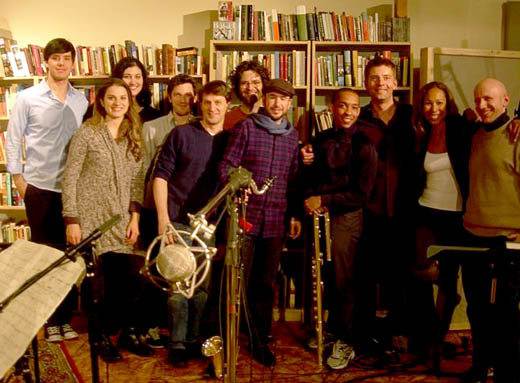
Oktaven session with ICE and composer / conductor Matthias Pintscher (l-r): Michael Nicholas (cello), Bridget Kibbey (harp), Wendy Richman (viola) Cory Smythe (piano), Ryan Streber (engineer), Nathan Davis (percussion), Josh Rubin (clarinet), Eric Lamb (flute), Matthias Pintscher (composer / conductor), Marisol Montalvo (Soprano) and Jacob Greenberg (producer)
“Part of my approach to getting a diffuse and nice live space that’s controlled was using all these books that we had,” says Streber. “Without the books, the space is very ringy – although I did break up the surfaces in ways that would cut down on any kind of anomalies. The books are not perfect diffusers, but they break up reflections and randomize things a bit. It smoothes out the sound of the room. And the nice side effect is that it made it feel a bit less like a studio, more homey.”
Streber makes use of absorbent panels and baffles to gain even more control over the room, and has equipment to make up the difference. “I’ve been able to find ways of matching the sound of the room with artificial reverbs that I like that I think make for a very natural final product. Winds up sounding more to the performer like what they would expect from a concert recording.”
Here, Streber notes his almost exclusive use of the Bricasti M7 reverb. “I’ll still use Altiverb for certain special things, or if I need additional channels of reverb. But mostly I’m able to treat mixes [as a whole] with the Bricasti because it’s often a group playing together. I’m trying to put everything in a very natural sounding (virtual) space.”
CLEAN VS. COLORED: NEW MUSIC SOUNDS & THE OKTAVEN GEAR
Streber’s technical approach to recording matches the openness of the new-music crowd in his appreciation of other eras and styles of sound. He and many of his clients are excited to explore the sonic possibilities of the studio – believing that recording is not, as classical purists see it, exclusively a matter of recreating a natural event.
“If the client wants a perfectly clean sound, I’ll go by that,” Streber assures. “But plenty of composers and performers come in and say they really want it to sound close-miked, they want it to sound exciting. And I love that as well. I think classical recording, especially contemporary music recording, kind of needs that. The recordings need to be treated as something unto themselves, and not just an attempt to recreate a live performance.”
Both recording methodologies are represented in Oktaven’s microphone cabinet and racks of gear. Coming from a classical background, Streber can execute either kind of recording – the uber-natural and the sublime.
“With traditional classical recording in the last 20 years there is this expectation that you have to use small diaphragm condensers going into ultra quiet solid state preamps straight to the converters with no processing or anything,” Streber explains. “I grew up listening to as much classical music as rock and classic rock and jazz, and whatever. And more and more I find younger classical musicians like the sound of records of all kinds that they grew up with.
“And so… I’m all for using tube mics, using ribbon mics, things that have their own kind of naturalism. In their own way, a U47 or an M49 have a great sense of naturalism – not that it’s an ultra flat, ultra clean idea of naturalism, but something else.”
At the same time, Streber notes: “I have the Schoeps and solid state Neumanns and DPAs – where I can do really clean captures if I want to. But in the studio, my default microphone for a main pair tend to be the Lucas CS-1s which I just cannot say enough good things about. And it’s funny, they’re not especially colored, but I think they’re much more sonically interesting than, say, DPA or B&K omnis or something.”
Recording and mixing to Pro Tools HD via the Studer 903 mixing console (formerly of the Metropolitan Opera House) and/or Dangerous D-Box, Streber also utilizes a very high quality collection of outboard gear, much of it notable with analog-loving indie rock engineers: API, Shadow Hills, Burl, etc.
“I love using analog outboard gear: I love the sound of my Inward Connections DEQ-1 and Thermionic Culture Phoenix mastering compressor. I really don’t go crazy with compression, but I also don’t feel like it’s a sin to use compression on classical music.”
It depends on the project. And as niche as Oktaven is, the projects can vary dramatically in nature.
“A lot of the projects I work on are groups that fall somewhere between chamber music and a band – a mixed ensemble with percussion or electric guitar, or a lot of special effects where you just need to get microphones right on the instruments, and I don’t see anything wrong with using the gear to enhance that.
“This started a long time ago,” he acknowledges, “Groups like Kronos Quartet and Bang on a Can made records decades ago that didn’t sound like a typical classical recording. But that’s become almost like a new norm. I almost expect when I hear about a new ensemble that it’s going to sound a little more like an indie record in a way than the straight TelArc string quartet recording.”
NEW SOUNDS ALL AROUND
In spirit and technical facility, Streber is working both ends of the “uptown” and “downtown” art music scenes at a time when that line is at its blurriest, with popular venues like Le Poisson Rouge, and programs like the Wordless Music Series featuring a balance of contemporary classical, rock, electronic, hip-hop, jazz and experimental music – where the typical headliners embody multi-hyphenate genres, and readily collaborate with each other. And these collaborations lead to an infusion of new sounds all around, which has resulted in more elaborately orchestrated arrangements on indie rock records and shows, and the proliferation of new music ensembles and innovative recordings.
“Nico Muhly is kind of a seminal figure in the production side of all this,” Streber points out. “He had a relationship with Björk and Valgeir Sigurðsson, and he also had a relationship with Philip Glass, and worked at Looking Glass. So by the time he put out his first record [2007’s Speaks Volumes] he’d had access to great studios and the freedom to experiment and do things differently.
“I think a lot of people have taken a cue from that. And also how successful he’s been at bringing concert music to non-classical audiences in a way that’s not compromising at all, but is working on its own terms.”
As ensembles experiment with their sound, recording studios and engineers will play a larger role in this movement. Oktaven is already seeing this trend.
“Ensembles have become more like bands and less like traditional string quartets or chamber orchestras,” Streber describes. “They play incredibly virtuosic and challenging music but they embrace it in a way that’s more similar to the way a band would rehearse and play a new song – they really seem to bring their own personality to it. The musicians have their own stake in the identity of the pieces and the composers are partnering with the musicians more closely. And there’s just a great energy about it and this sense that people are looking for sounds that are their own.”
A recent session at Oktaven with guitarist Rafiq Bhatia is a good example of this:
“Rafiq tracked his record at Systems Two [in Brooklyn]. It was basically a jazz combo, but very elaborate and complex music. He came to Oktaven with a young producer/composer named Alex Overington and they did something I hadn’t seen before – they actually went through the solos and the comps in these songs and orchestrated out the improvised elements into these very elaborate electronic and acoustic parts and they did all the overdubs here.
“It was incredible to watch them work through this stuff – having a piano solo doubled by a string quartet, or having a really elaborate bass line with harmonization by bass clarinet and bass flutes, etc. It was a really interesting take on not only blending genres but also blending the disciplines – taking highly improvised music and making it into something that’s actually notated, and very premeditated, after the fact.”
IT’S ON, AND ON
From its first session with composer/pianist Dustin O’Halloran and the ACME new music ensemble, and countless sessions since with highly regarded musicians like Claire Chase, Jacob Greenberg, Vicky Chow, and Dan Lippel, Oktaven has been running, strong. And the client pool for this particular studio is growing, its needs expanding.
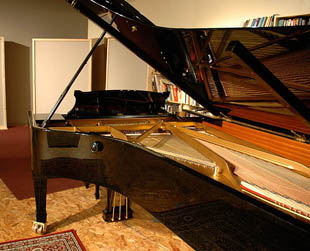
Oktaven’s 9’ Hamburg Steinway D concert grand – rebuilt by Klavierhaus and maintained by Arlan Harris, RPT.
“In my world, to get good sounds, you really need a decent room and good microphones and someone who knows how to capture that,” Streber notes. “And contemporary classical artists are less inclined to challenge that by recording themselves in their rehearsal spaces, basements, or bedrooms. At least for now! (laughs)”
As long as the economics make sense, and we presume they will only make more and more sense as the audience for new music grows, Streber will be making it work up in Yonkers, hoping to get more mixed-ensembles, more jazz combos, more experimental artists up to soak in the studio.
“It’s been two years, and I’ve been tweaking the room and making improvements ever since we opened,” he says. “Little by little we’re trying to keep growing and extending the gear and the flexibility the room offers.
“I learn every day, which is the best part of the job…I’m always growing as an engineer.”
Visit http://www.oktavenaudio.com for more information and to plan a visit, or book the studio.
Please note: When you buy products through links on this page, we may earn an affiliate commission.







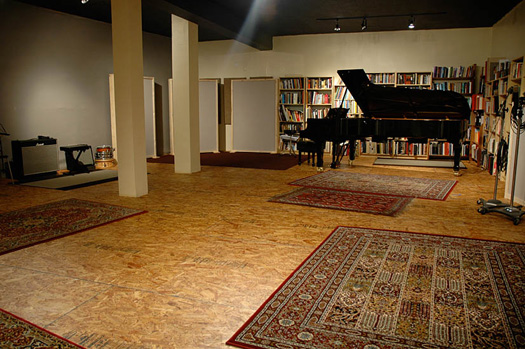
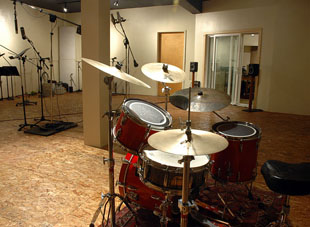
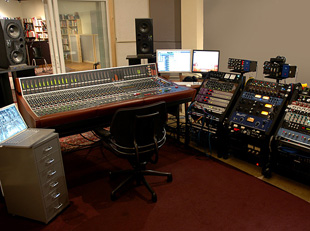
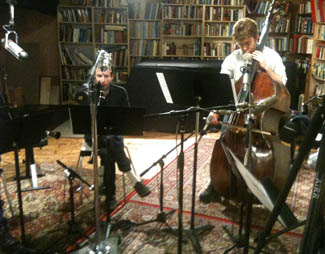
Mike
September 22, 2011 at 4:29 pm (14 years ago)Oktaven is a wonderful studio run by two wonderfully talented people. I would recommend them in a heartbeat to anyone.